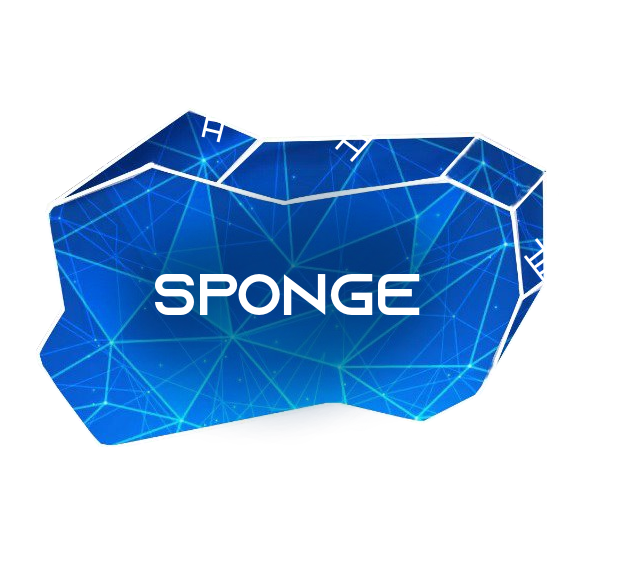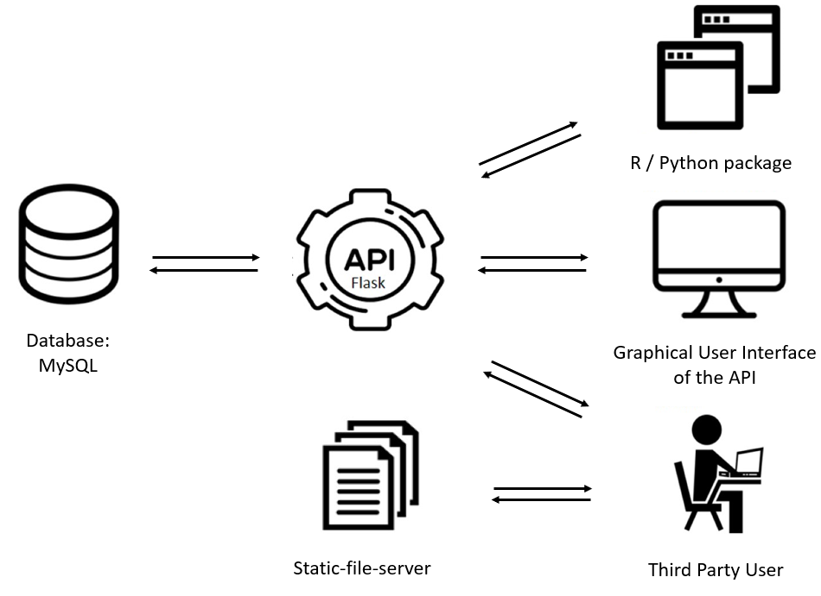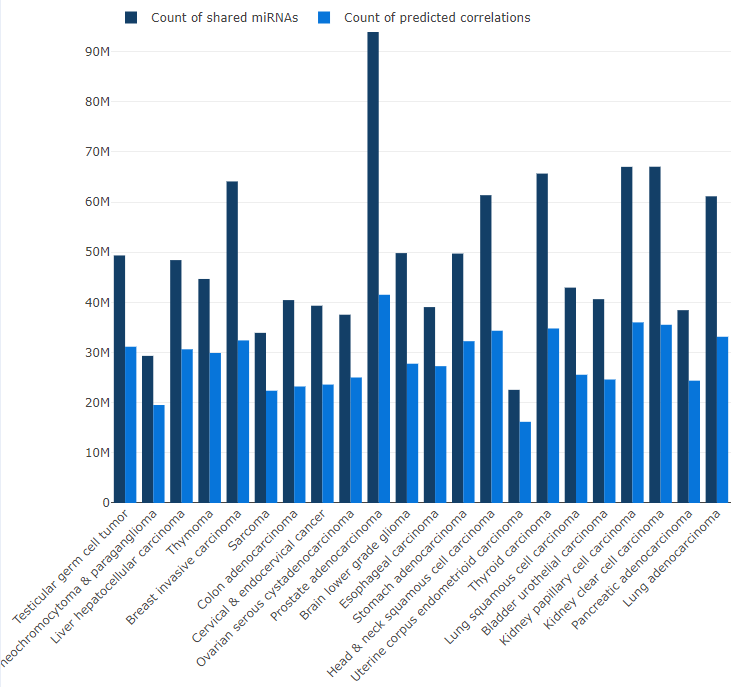Provides user-friendly usage of the SPONGE API.
Project description
SPONGE-web API
pip install spongeWebPy
import spongeWebPy
Purpose

With SPONGE being an outstanding approach regarding calculation speed and accuracy, the goal, making the data available in an easy way for as many researchers as possible, is the next logical step. Furthermore, the data should become visualized in an interactive network, for uncomplicated research within a small part of interest of the networks. Available ceRNA interaction networks are based on paired gene and miRNA expression data taken from "The Cancer Genome Atlas" (TCGA).
Introduction
MicroRNAs (miRNAs) are important non-coding, post-transcriptional regulators that are involved in many biological processes and human diseases. miRNAs regulate their target mRNAs, so called competing endogenous RNAs (ceRNAs), by either degrading them or by preventing their translation. ceRNAs share similar miRNA recognition elements (MREs), sequences with a specific pattern where the belonging miRNA binds to.
miRNAs act as rheostats that regulate gene expression and maintain the functional balance of various gene networks. Furthermore, the miRNA-ceRNA-interactions follow a many-to-many relationship where one miRNA can affect multiple ceRNA targets and one ceRNA can contain multiple MREs for various miRNAs, leading to complex cross-talk. Since failures in these systems may lead to cancer, it is crucial to determine the networks of interactions and to assess their structure.
SPONGE is a method for the fast construction of a ceRNA network using ’multiple sensitivity correlation’. SPONGE was applied to paired miRNA and gene expression data from “The Cancer Genome Atlas” (TCGA) for studying global effects of miRNA-mediated cross-talk. The outcome highlights already established and novel protein-coding and non-coding ceRNAs which could serve as biomarkers in cancer. Further information about the SPONGE R package are available under https://bioconductor.org/packages/release/bioc/html/SPONGE.html.
With SPONGE being an outstanding approach regarding calculation speed and accuracy, the goal was to make its results easily accessible to researchers studying ceRNAs in cancer for further analysis. Therefore, an application programming interface (API) was developed, enabling other developers to query a database consisting of the SPONGE results on the TCGA dataset for their ceRNAs, miRNAs or cancer-types of interest. Containing a large amount of statistically related ceRNAs and their associated miRNAs from over 20 cancer types, the database allows to detect the importance of a single gene on a large scale, thus assessing its relevancy in a cancer background.
Additionally, an interactive web interface was set up to provide the possibility to browse and to search the database via a graphical user interface. The website also facilitates processing the data returned from the database and visualizing the ceRNA interactions as a network. The website is available under https://exbio.wzw.tum.de/sponge/home. By help of these tools, third party developers like data scientists and biomedical researchers become able to carry out in depth cancer analyses and detect correlations between different cancer-causing factors on a new level while benefiting from an easy to use interface, which may lead to an uncomplicated and better understanding of cancer.
General Workflow

Structure of the SPONGE-Web project. A MySQL database contains all data of the different cancer types, with information about the genes, miRNAs and the ceRNA network. The API (immplemented with the Flask framework) controls the database and sends requests and accepts the answer. The API processes the data and sends it to the frontend (third party user like a R or Python package or website). At the website several visualization tools are provided. The database and the API represent the backend and the website, third party user represent the frontend.
How to start requests?
To start with further analysis with SPONGE data, it is important to get an overview about the available datasets/disease_types and the number of ceRNA interactions.

get_datasetInformation()
To retrieve all used parameters of the SPONGE method to re-create published results for the cancer type/dataset of interest, use the following function.
get_runInformation(disease_name = "kidney clear cell carcinoma")
Another way to get an overview of the results is to search for a specific gene and get and idea in which ceRNA interaction network the gene of interest contributes most to.
get_geneCount(gene_symbol = ["HOXA1"])
How to find a subnetwork?
To find a subnetwork of nodes of interest use the functions: Get all ceRNA interactions by given identifications (ensg_number, gene_symbol or gene_type), specific cancer type/dataset or different filter possibilities according different statistical values (e.g. FDR adjusted p-value).
# Retrieve all possible ceRNAs for gene, identified by ensg_number,
# and threshold for pValue and mscor.
get_all_ceRNAInteractions(ensg_number=["ENSG00000259090","ENSG00000217289"],
pValue=0.5, pValueDirection="<",
mscor=0.006, mscorDirection="<",
limit=15)
Get all ceRNAs in a disease of interest (search not for a specific ceRNA, but search for all ceRNAs satisfying filter functions).
get_ceRNA(disease_name = "kidney clear cell carcinoma",
gene_type = "lincRNA", minBetweenness = 0.8)
Get all interactions between the given identifiers (ensg_number or gene_symbol).
get_specific_ceRNAInteractions(disease_name = "kidney clear cell carcinoma",
ensg_number = ["ENSG00000259090","ENSG00000217289","ENSG00000152284"])
How to find sponged miRNA?
Find sponged miRNAs (the reason for a edge between two ceRNAs) with
get_sponged_miRNA(disease_name="kidney", gene_symbol = ["TCF7L1", "SEMA4B"])
or find a miRNA induced ceRNA interaction with
# Retrieve all possible ceRNA interactions where miRNA(s) of interest contribute to
get_specific_miRNAInteraction(disease_name = "kidney clear cell carcinoma",
mimat_number = ["MIMAT0000076", "MIMAT0000261"],
limit = 15)
Further Information and Analysis
The database also contains information about the raw expression values and survival analyis data, which can be used to for Kaplan-Meyer-Plots (KMPs) for example. These information can be adressed with package functions. To retrieve expression data use
# Retrieve gene expression values for specif genes by ensg_numbers
get_geneExprValues(disease_name = "kidney clear cell carcinoma",
ensg_number = ["ENSG00000259090","ENSG00000217289"])
# Retrieve gene expression values for specif miRNAs by mimat_numbers
get_mirnaExprValues(disease_name = "kidney clear cell carcinoma",
mimat_number = ["MIMAT0000076", "MIMAT0000261"])
To get surival analysis data use the function
get_survAna_rates(disease_name="kidney clear cell carcinoma",
ensg_number=["ENSG00000259090", "ENSG00000217289"],
sample_ID = ["TCGA-BP-4968","TCGA-B8-A54F"])
It returs a data_frame with gene and patient/sample information and the "group information" encoded by column "overexpressed". Information about expression value of the gene (FALSE = underexpression, gene expression <= mean gene expression over all samples, TRUE = overexpression, gene expression >= mean gene expression over all samples)
For furhter patient/sample informations:
get_survAna_sampleInformation(disease_name = "kidney clear cell carcinoma",
sample_ID = ["TCGA-BP-4968","TCGA-B8-A54F"])
Citation
If you use any results from spongeWeb, please cite as follow:
Pachl, E., Hoffmann, M., Stiegler, V., Hartung, M., Schulz, M. H., List, M., SPONGE-web: A pan-cancer resource for competing endogenous RNA interactions (manuscript in preparation)
Project details
Release history Release notifications | RSS feed
Download files
Download the file for your platform. If you're not sure which to choose, learn more about installing packages.
Source Distribution
Built Distribution
Hashes for spongeWebPy-1.0.2-py3-none-any.whl
| Algorithm | Hash digest | |
|---|---|---|
| SHA256 | 6d6cba8bdbc752381ff10f8bbc8e7604b0391a6321113f25476086ae9e2fe67f |
|
| MD5 | f75202d8d1807e3d4d3e9d21b34819d4 |
|
| BLAKE2b-256 | cad5e5add4dc017c0e1bbdb22fb94e6da6b4ae8fdb363123e1ed18caf185b07c |











